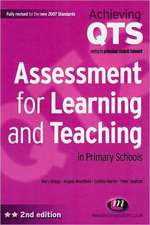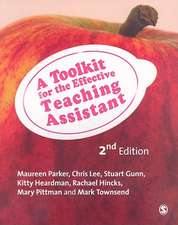Getting Serious About the System: A Fieldbook for District and School Leaders
Autor D'Ette F. Cowan, Stacey L. Joyner, Shirley B. Beckwithen Limba Engleză Paperback – 8 aug 2012
Working on the underlying issues and people that impact the system
Gathering support from all staff members to maximize time, resources, and energy.
Preț: 284.56 lei
Nou
Puncte Express: 427
Preț estimativ în valută:
54.45€ • 56.85$ • 44.96£
54.45€ • 56.85$ • 44.96£
Carte tipărită la comandă
Livrare economică 15-29 aprilie
Preluare comenzi: 021 569.72.76
Specificații
ISBN-13: 9781452205113
ISBN-10: 1452205116
Pagini: 160
Dimensiuni: 216 x 279 x 13 mm
Greutate: 0.45 kg
Ediția:New.
Editura: SAGE Publications
Colecția Corwin
Locul publicării:Thousand Oaks, United States
ISBN-10: 1452205116
Pagini: 160
Dimensiuni: 216 x 279 x 13 mm
Greutate: 0.45 kg
Ediția:New.
Editura: SAGE Publications
Colecția Corwin
Locul publicării:Thousand Oaks, United States
Recenzii
"This book is a critical roadmap to district and school transformation. It takes the guess work out of determining where improvement is needed."
"The working systemically model provides a research-based approach to school improvement. The clearly defined step-by-step approach will assist any school or district in its improvement efforts. My professional practice has been significantly changed as a result of my direct experience implementing SEDL’s working systemically approach."
"This book not only describes processes and strategies but provides the tools needed for those leading the process. This is a process that a campus or district leader could use that would examine and use the resources they already have and is not another program they need to buy."
"The vignettes pulled everything together and increased my understanding of the phases. The tips for building relationship between team members and dealing with sensitive issues are also very helpful."
"This is the most comprehensive approach to improving a school system that I have seen in one text. I would absolutely recommend this book to my colleagues."
"This book challenges leaders to focus on what is most important and identifies the improvement efforts required to achieve dramatic results in the classrooms. It is brimming with ideas on how to transform education systemically and provides teachers, administrators, and leaders with a comprehensive resource to improve student achievement."
“The authors provide decades of high-quality professional development and hands-on work with schools and school districts. I appreciate and applaud their efforts to translate research on data use, professional development, leadership, and collaboration into tools and processes useful to educators.”
"The working systemically model provides a research-based approach to school improvement. The clearly defined step-by-step approach will assist any school or district in its improvement efforts. My professional practice has been significantly changed as a result of my direct experience implementing SEDL’s working systemically approach."
"This book not only describes processes and strategies but provides the tools needed for those leading the process. This is a process that a campus or district leader could use that would examine and use the resources they already have and is not another program they need to buy."
"The vignettes pulled everything together and increased my understanding of the phases. The tips for building relationship between team members and dealing with sensitive issues are also very helpful."
"This is the most comprehensive approach to improving a school system that I have seen in one text. I would absolutely recommend this book to my colleagues."
"This book challenges leaders to focus on what is most important and identifies the improvement efforts required to achieve dramatic results in the classrooms. It is brimming with ideas on how to transform education systemically and provides teachers, administrators, and leaders with a comprehensive resource to improve student achievement."
“The authors provide decades of high-quality professional development and hands-on work with schools and school districts. I appreciate and applaud their efforts to translate research on data use, professional development, leadership, and collaboration into tools and processes useful to educators.”
Cuprins
Preface
Acknowledgments
About the Authors
Introduction to Systemic Improvement
Systems Thinking
Systems Thinking in Education
Working Systemically: A Process Grounded in Research
Testing and Refining the Working Systemically Approach
The Working Systemically Approach: Levels, Components, and Competencies
What It Takes
Summary
References
1. The "Works" of Working Systemically
Levels of the System
Components of the System
Competencies for Working Systemically
The Working Systemically Approach in Action
2. Phase I: Understanding Systemic Improvement
Step 1. Study the Approach
Step 2. Collect and Analyze Preliminary Data
Step 3. Present the Approach at the School Level
Step 4. Commit to Systemic Improvement
3. Phase II: Analyzing the System
Step 1. Form the District and School Leadership Teams
Step 2. Begin the Comprehensive Needs Assessment
Step 3. Conduct a Gap Analysis
Step 4. Begin the Process at the School Level
Step 5. Formulate Problem Statements
Step 6. Describe the Ideal State
Step 7. Review System Initiatives
Step 8. Continue the Process at the School Level
4. Phase III: Planning Action
Step 1. Investigate Research-Based Practices
Step 2. Explore the Professional Teaching and Learning Cycle (PTLC)
Step 3. Review Progress Made to Date and Existing Plan
Step 4. Develop a District Improvement Plan
Step 5. Formalize and Communicate the District Improvement Plan
Step 6. Develop School Improvement Plans
5. Phase IV: Taking Action & Monitoring Progress
Step 1. Implement and Monitor the Improvement Plans
Step 2. Provide Continuing Leadership for the Improvement Work
Step 3. Address Unique Challenges as They Arise
6. Phase V: Assessing & Reflecting on Outcomes
Step 1. Analyze and Reflect on Evidence of Implementation and Impact
Step 2. Decide on a Focus for Continuing the Improvement Work
Step 3. Recognize Work, Progress, and Accomplishments
Bibliography Matrix
Index
Acknowledgments
About the Authors
Introduction to Systemic Improvement
Systems Thinking
Systems Thinking in Education
Working Systemically: A Process Grounded in Research
Testing and Refining the Working Systemically Approach
The Working Systemically Approach: Levels, Components, and Competencies
What It Takes
Summary
References
1. The "Works" of Working Systemically
Levels of the System
Components of the System
Competencies for Working Systemically
The Working Systemically Approach in Action
2. Phase I: Understanding Systemic Improvement
Step 1. Study the Approach
Step 2. Collect and Analyze Preliminary Data
Step 3. Present the Approach at the School Level
Step 4. Commit to Systemic Improvement
3. Phase II: Analyzing the System
Step 1. Form the District and School Leadership Teams
Step 2. Begin the Comprehensive Needs Assessment
Step 3. Conduct a Gap Analysis
Step 4. Begin the Process at the School Level
Step 5. Formulate Problem Statements
Step 6. Describe the Ideal State
Step 7. Review System Initiatives
Step 8. Continue the Process at the School Level
4. Phase III: Planning Action
Step 1. Investigate Research-Based Practices
Step 2. Explore the Professional Teaching and Learning Cycle (PTLC)
Step 3. Review Progress Made to Date and Existing Plan
Step 4. Develop a District Improvement Plan
Step 5. Formalize and Communicate the District Improvement Plan
Step 6. Develop School Improvement Plans
5. Phase IV: Taking Action & Monitoring Progress
Step 1. Implement and Monitor the Improvement Plans
Step 2. Provide Continuing Leadership for the Improvement Work
Step 3. Address Unique Challenges as They Arise
6. Phase V: Assessing & Reflecting on Outcomes
Step 1. Analyze and Reflect on Evidence of Implementation and Impact
Step 2. Decide on a Focus for Continuing the Improvement Work
Step 3. Recognize Work, Progress, and Accomplishments
Bibliography Matrix
Index
Notă biografică
Descriere
This fieldbook's multidimensional approach to raising student achievement offers strategies for aligning curriculum, instruction, and assessment to state and Common Core State Standards.














